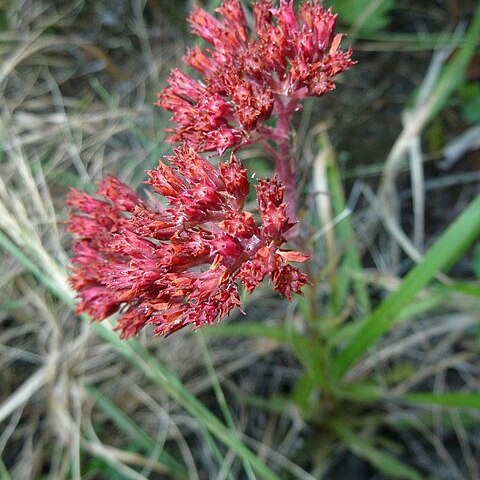Rosette-leaves up to 16(20) x 2·5 cm., oblong-lanceolate or lanceolate, attenuate towards the acute apex, entire and ciliate or pectinate-ciliate at the margin (the cilia usually nearly contiguous, acute), sessile and connate at the base, flat, fleshy but not very thick, usually glabrous, sometimes papillose-pilose, green, sometimes with purple marks or ± purple beneath, deflexed; cauline leaves similar to the basal ones but usually smaller, the lower longer than the internodes, the upper successively shorter, becoming erect and ± clasping the stem, the upper cauline leaves sometimes ovate-lanceolate or elliptic-oblong, sometimes nearly bract-like; sheaths of lower cauline leaves 0·2-0·8(1·2) cm. long, those of the upper ones very short.
Perennial or biennial herb, succulent, with one rosette, leaf pairs spirally arranged, old ones remaining on stem, ± 0.5 m high when flowering, tuberous rootstock. Leaves lanceolate to linear-triangular, 60-150 x 5-15 mm, acute, drying from apex, dorsiventrally flattened, folded, glabrous except for marginal cilia, dark green to yellowish green with purple marks. Inflorescence a flat-topped thyrse, many pedicellate flowers; peduncle with leaf-like bracts, shortening upwards. Calyx fleshy, acute tapering into stout hair, with marginal cilia, green. Corolla tubular, fused 0.2-0.5 mm, pink to white; lobes oblong to obovate, 3.0-5.5 mm long, acute, slightly hooded, erect scarcely recurved. Flowering time Feb.-Apr.
Corolla (4·5)5·7 mm. long; petals 1·25-2 mm. broad, oblong, obtuse or subacute, erect but with ± reflexed or spreading tips, mucronate below the slightly inflexed apex, sometimes minutely scabrid outside towards the apex, white, greenish-white flushed with pink or bright to deep red.
Calyx (2·5)3-5·5(6·5) mm. long, usually longer than 5 corolla to equalling it; sepals 1-1·25 mm. broad, lanceolate to linear-lanceolate, very attenuate, ± acute, Sérrulate or denticulate to ciliate-pectinate at the margins (cilia acute, ± rigid), or entire, green or reddish-purple.
Stem ± stout, erect, terete, simple, fleshy, from base to apex ± covered all around with retrose, appressed, whitish, ± long hair-like papillae (or papillae short, obtuse or acute, sometimes nearly bulliform), rarely glabrous, fleshy, green or reddish-purple.
Flowers 5-merous, arranged in a terminal, ± dense, up to 17(30) cm. in diam., corymbose, flat-topped inflorescence, with papillose or hairy branches; pedicels up to 15 mm. long, glabrous or nearly so.
A perennial or biennial succulent herb up to 90 cm. high with a tuberous root producing one to many flowering stems, surrounded at base by dense rosulate leaves which usually disappear at anthesis.
Filaments (2)2·5-3(3·5) mm. long; anthers (0·5)-0·75(1) mm. long, rectangular.
Scales ± 0·5 mm. long, rectangular or subquadrate, truncate.
Follicles (2·75)3-5-5·5 mm. long including the styles.
Erect herb to 3 ft. high. with stout stem
Flowers white.

